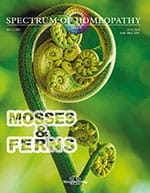Mosses and Ferns - Spectrum of Homeopathy 2021/2
They still exist – the primordial plants that first greened the earth over 400 million years ago. Yet now they are so small and inconspicuous that we hardly notice them. This is also true of the patients who are helped by potentised mosses and ferns. This issue of SPECTRUM should aid recognition of these remedies with such strange names as square goose neck moss (Rhytidiadelphus squarrosus) so that we no longer overlook them in our homeopathic practice. They are brought to our attention by a group of “moss pioneers” headed by Britta Dähnrich and Jan Scholten, who in spring 2017 proved about 30 different mosses with the help of bryologist Michael Sauer. Up to that time these ancient plants, with approximately 15,000 species, were still completely uncharted territory for homeopathy. Now the pioneers can already report first practical success with these unassuming and hard-to-differentiate flowerless plants that are found everywhere, in the wide forests, on wood, cliffs, walls and roofs.
We, the editors of SPECTRUM, vividly shared the emotions of the participants at the first sense provings: primarily confusion! Then something like a primordial scream! Complete helplessness in view of the complexity of the evidence. Gradually the central theme of the mosses became clearer: being overlooked and not perceived due to maximum adaptation and frugality, which are the expression of the absolute will to live.
In the case histories here we get to know the primordial plants that we so carelessly trample on as a homeopathically efficacious companion for patients with poor performance, depression, and other psychological disorders, mostly following traumatic childhood experiences. The experience of earlier rejection, isolation, abuse, violation and mortal danger is a common thread running through the cases of Elisabeth Sehlinger, Britta Dähnrich, Christina Ari, Martin Jakob and Franz Swoboda on different mosses. Whereas the remedy group based on such typical common themes can be clearly recognised, the differentiation of individual moss remedies remains mostly difficult. Jan Scholten’s hypotheses on the plant codes can help although these need to be reliably confirmed in practice.
Michal Yakir has developed her own system of classification for the primordial plants. Whereas her well-known classification of the flowering plants follows the stages of human evolution and individuation, she now assigns the non-flowering ancient plants, including the conifers, to the stages of development of Gaia, the earth. The mosses are right at the beginning of evolution in the first column of Yakir’s tried-and-tested plant table. In columns 2 and 3 come the club moss and ferns of the Pteridophyta, for which our dear author and friend Jörg Wichmann (who died far too young) contributed an overview. These plants are also striking in their very inconspicuousness. So just as fern seeds can make people invisible according to myth and legend, people who need fern remedies have learnt to hide themselves in the camouflage of everyday life. Franz Swoboda and Doris Drach reveal this strategy with the proving and a case of bracken fern.
There are clearly many parallels between mosses and ferns relevant to homeopathy, such as the theme of trauma and sexual abuse in Sigrid Lindemann’s case of Equisetum hiemale. The genus Selaginella (spikemosses or lesser clubmosses) forms a bridge between the two plant groups of this issue. Like a moss, these lycopods or lycophods survive years of drought and, like the false rose of Jericho, they spring to green life with the rain, as does the woman in Anne Schadde’s case, following a dose of her simillimum Selaginella lepidophylla.
In this issue of SPECTRUM we likewise encounter a series of patients and homeopaths who have searched many years for the key to healing only to finally find it in this group of primordial plants. These examples show how important it is, even after 200 years of homeopathy, to extend our materia medica with new remedy provings and clinical experience. Maybe you have hard-to-treat patients, some of whom could benefit from Lunularia cruciata, Aulacomnium palustre or Asplenium scolopendrium.
- Author: Narayana Verlag
- ISBN: No ISBN
- 86 pages
- Paperback
- Published in 2021
- Printed in Germany

